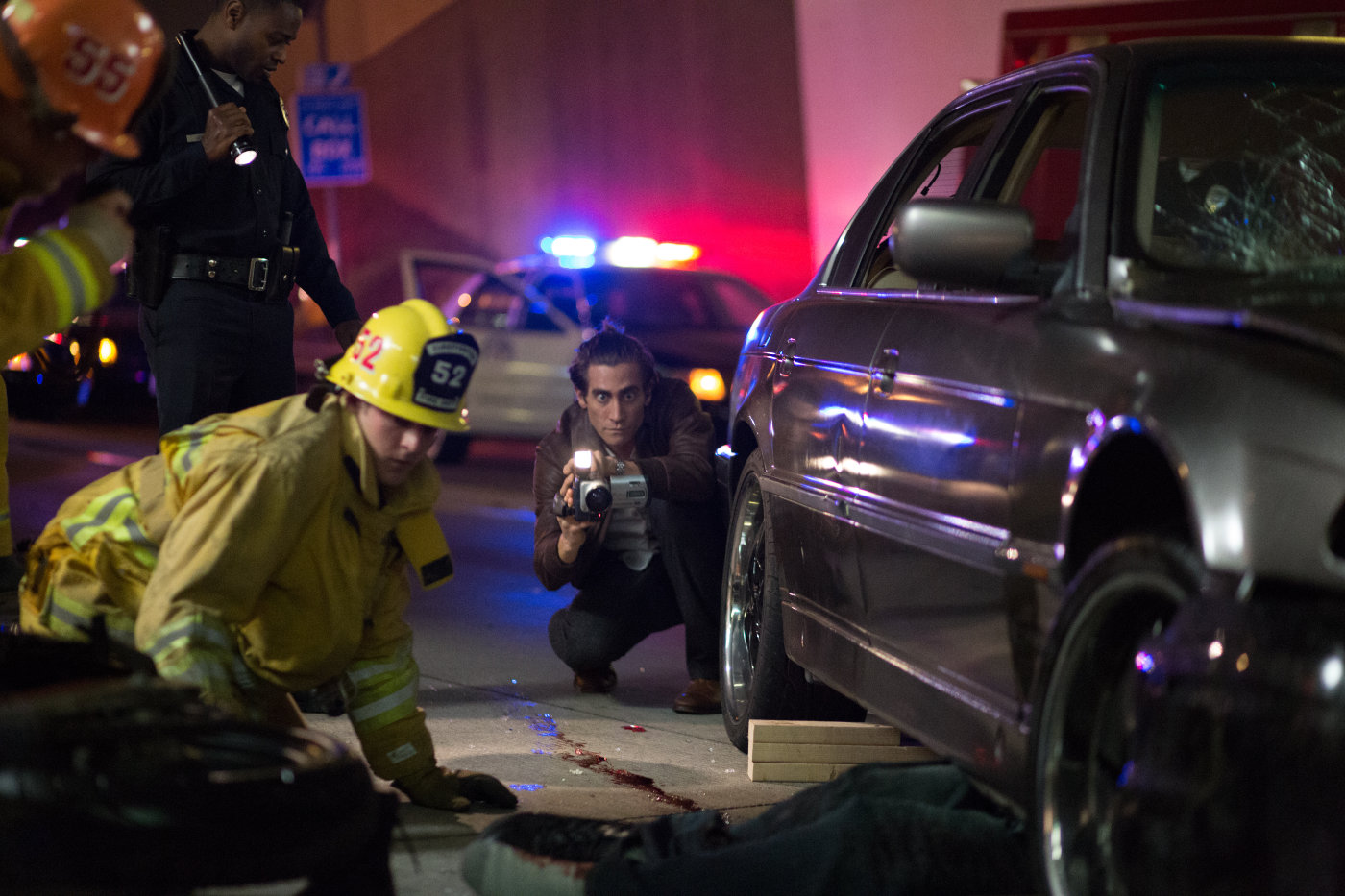My BLink column last Saturday:
The artifice inherent in the media’s representation of the real, and the yawning abyss opened up by our insatiable appetite for ‘up-close reality’, form the crux of Nightcrawler.
The artifice inherent in the media’s representation of the real, and the yawning abyss opened up by our insatiable appetite for ‘up-close reality’, form the crux of Nightcrawler.
When we first see Jake Gyllenhaal in Nightcrawler, he’s prowling around a restricted area of Los Angeles, stealing copper wire to sell for scrap. With his hollow-eyed intensity and sad, furrowed brow, Gyllenhaal’s Lou Bloom initially gives off a tragic vibe: a jobless young man gamely trying to get the guy buying his stolen stuff to hire him. By the film’s end, the whites of his eyes glinting in his pale, drawn face make you think of nothing so much as a vampire. He has become a creature of the night.
Night is both setting and metaphor in Dan Gilroy’s film. His LA is a nest of crisscrossing aerials in which whirring helicopters seem more at home than birds. Day doesn’t really exist here. We either hurtle through the stomach-churning darkness of the freeway, as if through some terrible post-modern rabbit hole, or gaze in wonder at the city’s eerie neon-lit skyline.
The first time we see the LA skyline here, it is a breathtaking big-screen homage to the LA we think we know — but really only know from the movies. The second time, we hear Lou Bloom say with a twinge of something like yearning, “On TV, it looks so real,” and find we are looking at the same skyline, except it is really a screen. Inside the television studio.
The artifice inherent in the media’s representation of the real, and the yawning abyss opened up by our insatiable appetite for ‘up-close reality’, form the crux of Nightcrawler. Early in the film, Bloom happens to arrive at the scene of an accident, and finds a freelance camera crew that arrives just behind the police, filming the ‘action’ to sell to the highest bidding television channel. “If it bleeds, it leads,” drawls the fleshy-faced cameraman Joe (Bill Paxton).
With the swift acquisition of a basic camcorder and a radio to tap into police frequencies, Bloom is soon giving Joe a run for his money. But it is the bluish dark of the editing room — contrasted not with bright sun, but with the artificial glare of the television screen — where the film is most at home. It is in this shadowy half-light, in the company of a slightly desperate TV producer called Nina (Rene Russo), that Bloom discovers that he has found his metier — and that there’s money in it.
“I want something people can’t turn away from,” says Nina, as she dismisses her colleague’s ethical and aesthetic hesitation about putting on air the increasingly graphic, invasive video footage that Bloom brings her. The other crucial criterion for what she wants — so obvious to Nina, and even to Bloom, that it doesn’t even need stating — is immediacy. As Mary Ann Doane argued in her classic 1990 essay ‘Information, Crisis, Catastrophe’, what television really deals in is time. TV’s greatest technological prowess “is its ability to be there — both on the scene and in your living room”. But though it promises us a supposedly “chance” encounter with the “reality” of catastrophe, what actually appears on television is cut to a predictable pattern. “Television shocks, and then repeatedly assures, a comforting presence in an unsure world,” wrote Doane.
Bloom catches on to these modalities quickly (“I’m a very fast learner”), having glowered through one car crash where he arrives too late to catch anything worth shooting. From there on, he has to be the first one to get to the scene, driving at insane speeds, even as his bumbling assistant Rick (Riz Ahmed) panics inside the crazily careening car.
The film plays with our fascination with speed and technology, the flip side of which is our fascination with the potential failure of that technology: the accident. The crash is the ur-form of television catastrophe, as Gilroy seems to instinctively understand. Then he raises the pitch, moving into the terrain of violent crime — preferably (as Russo’s character points out), a crime with a well-off, white target. Here, the ‘catastrophe’ has a perpetrator as well as an intended (rather than accidental) victim, allowing for television to produce a deeper sense of insecurity.
As you watch Bloom’s increasing interventions in the ‘form’ of his images — pulling a body into the car headlights for a better ‘frame’ — you know this can only be leading us in one direction, and it does.
What makes Nightcrawler so chilling to watch is that its bloodthirsty world is made to feel like a dystopic future — whereas in fact it already exists. And I’m not talking about LA’s 100-miles-an-hour stringers-slash-nightcrawlers either, though Gilroy has spoken of meeting them. In India, we may not have reached these levels with regard to covering urban crime, but we’re well on our way to having a television media whose sense of power comes not from revealing reality but from orchestrating it. Why search for news that’s television-worthy, when whatever is on television is news? Having once tasted the god-like pleasures of creating events, why would anyone want to go back to merely reporting them?

No comments:
Post a Comment